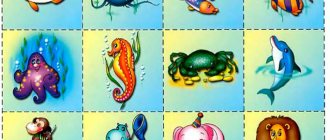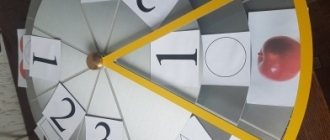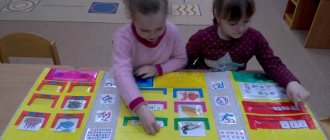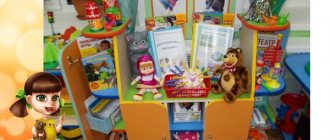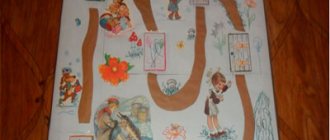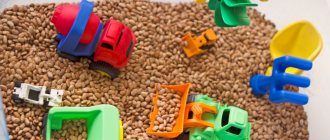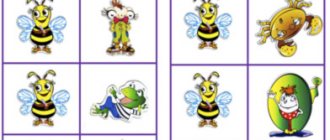Passport for the multifunctional teaching aid “Vsyusha the Doll”
KSPO "Nursery No. 40", p. Denisovka, st. Sovetskaya, 32 a
Phone/fax 8 (714-34) 2-14-37
______________________________________________________________________________
Passport of a multifunctional teaching aid
“Everything Doll”
Author: Mityukhina Tatyana Viktorovna methodologist of the Municipal State Public Enterprise “Nursery No. 40”
Denisovka village
November 2017
Here's the doll. And everything about it is simple:
Figure, eyes and hairstyle She is short,
it's a small "fabric". And although there is no living heart in her bosom, perhaps, But life also lives next to her lover. I love her and suffer, Playing all her games, Collecting moments of a happy life drop by drop.
Purpose of this guide:
Development of students' independence and initiative, interests and cognitive abilities, intellectual development based on practical actions, development of students' creative potential in the game.
Tasks:
develop curiosity and cognitive motivation
• develop imagination and creativity
• form primary ideas: about yourself, other people, your small homeland, about objects in the surrounding world, about the properties and relationships of objects in the surrounding world (shape, color, size, material, quantity, part and all, space, movement and rest, reasons and consequences, etc.)
• enrich and activate vocabulary
• develop all types of perception: visual, auditory, tactile-motor.
Methodological value:
A multifunctional manual aimed at solving several problems at once, it is intended for working with children of different ages and allows taking into account the individual characteristics of the child’s development.
The variation of the exercise has no limits. The guide can be constantly updated with new elements.
Application area
The mat can be used in joint activities between a teacher and children, in independent children’s activities (manipulating various objects) and in individual work with a child. Finds application in all areas of education
Children's age
: from 2 to 6 years
The teaching aid is a large papier-mâché doll covered with padding polyester and soft flannel fabric. The doll's hands are soft and easy to fold.
The head is lined with flannel fabric, allowing you to quickly and easily change looks with interchangeable felt pieces.
The doll's name is Vsyusha. He says the doll can be used anywhere, in any activity with children: educational, educational, outside of school.
The benefit is intended for children from 2 to 6 years old.
What else to read: Development of fine motor skills in young and middle-aged children in modeling classes
The manual is multifunctional. This toy is a transformer.
Vsyusha is not just an educational doll, she is an excellent friend and assistant for our children and teachers.
Vseyusha is an active working method in educational activities (as play motivation). Such an assistant can be used as a special method of working in the classroom.
She easily, imperceptibly for children, switches from one character to another, which makes her mysterious, “alive.” Just turn around, change the wig, eyes, lips and eyebrows and now preschoolers have a completely different hero!
The doll's head has Velcro fasteners for attaching removable wigs made of colored yarn and synthetic hair.
Removable parts - eyes, lips, eyebrows, beard, mustache - are made of soft felt. This allows you to change the image of the doll in seconds; such a toy is simply irreplaceable in a group, because it is very convenient and compact.
By communicating with the doll, children gain sensory experience, become familiar with basic colors, professions, fairy tale characters, seasonal changes in nature, and emotions.
With the help of Vsyusha, it is easy and fun to learn to count, read, and explore the world of emotions and theater.
Vsyusha’s chest contains a lot of clothes and accessories, which are in separate boxes:
- wigs
- removable parts (eyes, lips, beard, eyebrows)
- costumes “Seasons” (autumn, winter, spring, summer)
- costumes “Fairy-Tale Heroes” (Kuzya the Brownie, Baba Yaga, Thumbelina, Malvina, Snow Maiden, Mashenka, Grandfather, Woman, Little Red Riding Hood, Foxes, Teddy Bear, Rabbit, Cat, Dog, Boh)
- national costumes (Russian, Kazakh, Tajik, Azerbaijani, Ukrainian (women's, men's), Lithuanian, German, Georgian, Belarusian, Uzbek)
- full “Watercolor”
- headwear (scarves, hats, caps, headbands, crowns, garlands)
- training aprons (with two transparent pockets, three transparent pockets and regular pockets in different colors)
- professions (doctor, cook, teacher, fireman, traffic inspector, hairdresser)
- seasonal clothing
- accessories (bags, belts, beads)
Here, in the chest, is a series of didactic materials (cards: “Studying colors”, “Mixing colors”, “Gzhel”. “Khokhloma”, “Gorodets painting”, “Decorative elements of painting”, “Pets”, “Wild animals” , “Vegetables”, “Fruits”, “Dangerous objects”, household appliances”, “Numbers”, “Russian, Kazakh, English language letters”, “Study of emotions”, “Products”, “Kazakh ornament”, “Edible and inedible mushrooms”, “Geometric shapes”.
- decorative elements with Velcro: flowers, colorful leaves, cups, snowflakes, droplets
The Vsyusha doll comes complete with flannel, decorative fastenings - four seasons with Velcro.
Vseyusha is a wonderful guide that has developmental, educational and educational significance. It can be used in almost all types of educational activities, games, work, art and independent activities.
Manipulations with various materials: buttons, drawstring, braid contribute to the development of fine motor skills of the hands.
Vseyusha is the main character of the study of life safety in the senior group.
In such classes, Vsyusha turns into housewife Kuzya, with the help of whom children learn the rules of safe behavior. Due to the fact that all parts of the doll's head are removable, it is very easy and interesting to explore the world of emotions.
What else to read: Modeling with children 3-4 years old. Lesson notes (3 pages)
During science lessons, Vsyusha turns into a small drop “Kapitoshka”, with which children enjoy exploring the world of living and inanimate nature.
In lessons to familiarize themselves with the environment, Vsyusha introduces children to the world of professions, and in fiction lessons, Vsyusha is the hero of her favorite fairy tales.
In a mathematics lesson, Vsyusha, in the guise of a “learned professor,” teaches children to count and solve simple problems.
During drawing lessons, Vsyusha turns into a “Watercolor” sorceress, who teaches children to mix colors and get new shades, to distinguish between warm and cold tones (on Vsyusha’s hand there are buttons with which a sun or a snowflake is depicted attached to his palms, symbolizing cold and warm shades colors), and sometimes he approaches children in the image of a young woman from Dymkovo or “Gzhelka” and introduces children to folk crafts.
During music lessons, Vsyusha also does not remain idle and easily turns into a cheerful note, bringing homework to the children. Together with her, the children go to the magical country of Muzland.”
Physical education is also not complete without Vsyusha. You are a frequent visitor here. The children show her their abilities. If the exercises are performed correctly, Vsyusha smiles, if she gets angry at mistakes.
Vsyusha helps to reconcile grumpy children. In her wardrobe there is a special “peace” apron with a large glove where children attach their palms for reconciliation.
In addition to all of the above, Vseyusha can also have the appearance of a fairy-tale animal. To do this, you just need to put on a skirt or trousers with the desired tail and put on a cap. The right hero is always at hand.
In addition, the doll does not take up much space in the group and is its decoration.
Children love Vsyusha because it is very interesting to play with her and with teachers, because it is very interesting to teach with her.
I think teachers will like my idea of a universal doll, and the Vsyusha doll will take root in children’s rooms, becoming even better!
Principles laid down in the new standards
Among the basic principles that are included in preschool education, we highlight:
- the fullness of the child’s life at all stages of his childhood, the opportunity for development;
- creating educational trajectories based on the individual characteristics of each child;
- full cooperation between children and adults;
- supporting children's creative initiative in a variety of activities.
Educational and methodological aids for preschool educational institutions should help to familiarize preschoolers with social and cultural norms, family values, and pride in their country.
In addition, it is important in preschool age to form a child’s cognitive interest in various types of activities.
Educational and methodological aids for the program from birth to school according to the Federal State Educational Standard take into account the age adequacy of preschool education. All teaching materials must meet the age requirements and developmental characteristics of children.
List of benefits, educational programs for the implementation of Federal State Educational Standards (DO)
We offer an approximate list of those materials that meet the requirements of new educational standards introduced into preschool educational institutions related to the physical and psychological education of the younger generation.
- E. Ya. Stepanenkova wrote the manual “Physical Education of Children in Kindergarten”, published by Mosaic-Synthesis in 2006.
- M. A. Runova. The book “Motor Activity in Kindergarten” was published in 2000.
- M. A. Runova. The manual “Acquaintance with nature through movement” was published in 2005.
Of interest are the following teaching materials recommended for use by the Ministry of Education that comply with the new educational standards:
- Manual by M. A. Runova “Physical training equipment for preschool educational institutions” published in 1999.
- A book by L. D. Glazyrina about physical education for preschoolers, published in 2004.
- Material by L.V. Yakovleva on the physical development and health of children aged 3-7 years, which appeared in print in 2003.
- The educational and didactic manual, authored by A.P. Shcherbak, is dedicated to thematic activities and holidays in a preschool institution. It was published in 1999.
- The author T. L. Bogina offers material on health protection in preschool institutions, 2006.
- Material dedicated to raising a healthy child was published by M. D. Makhaneva in 1997.
- A manual that allows you to raise gifted and talented children was created by L. A. Wenger in 2000.
This list includes many more benefits, each of which is aimed at creating a healthy generation that loves its country and respects the traditions of the people.
Directions of child development and education
Educational and methodological aids recommended for preschool educational institutions cover cognitive, social-communicative, speech, physical, artistic, and aesthetic development.
To fulfill all the tasks assigned to teachers of preschool institutions, the content-rich part of the benefits should include gaming, recreational, and sports equipment that allows for the research, cognitive, and creative activity of all children, the formation of fine motor skills, and the promotion of a favorable emotional environment and self-expression of children.
Objectives of the manuals
New teaching aids, recommended for use in the preschool system according to the new Federal State Educational Standards, are aimed at providing every child with the right to quality preschool education. The teacher’s task is to protect the psychological and physical health of children, providing equal opportunities for self-development of each child, regardless of place of residence, nationality, language, as well as the social status of his parents.
Teaching aids recommended by the Ministry of Education for use in preschool educational institutions must ensure continuity of education. They must create favorable conditions, taking into account the age and individual characteristics of children, and promote the manifestation of the creative potential of the younger generation.
Continuity
Teaching aids for primary schools are also being developed taking into account the requirements of the new standards. Among the books that can be recommended to primary school teachers, we note the following materials:
- S. A. Kozlova. "I am human. Program for the Social Development of the Child" - Moscow, "School Press", 2003;
- K. Yu. Belaya. “Me and my safety. Thematic Dictionary in Pictures" Moscow, "School Press", 2010;
- V. I. Semenyuk. “Study of traffic rules” - Moscow, “Prosveshcheniye”, 1996;
- R. B. Sterkina. “Fundamentals of safety for primary school age” - Moscow, “Prosveshcheniye”, 2000;
- L. Ya. Kondykinskaya. “Classes on patriotic education in kindergarten” - Moscow, “Sfera”, 2010.

